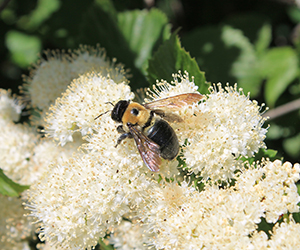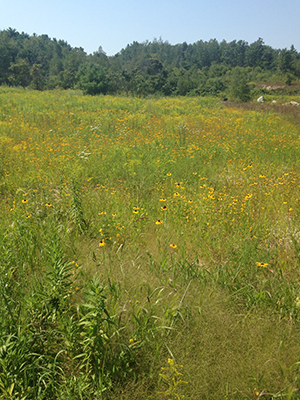Pollinators in New Hampshire
Important Information on Pollinators in New Hampshire
 Project Goal: Pollinator populations are in decline in New Hampshire and around North America, due to a variety of factors including: habitat loss and fragmentation, use of pesticides, introduced exotic invasive species, climate change, and the associated loss of native plant diversity. Species like the iconic monarch, and the American bumble bee, have been identified as Species of Greatest Conservation Need (SGCN) due to population declines. The Nongame and Endangered Wildlife Program supports pollinator conservation throughout New Hampshire by providing technical assistance to schools, towns and large utility and transportation rights-of-way managers.
Project Goal: Pollinator populations are in decline in New Hampshire and around North America, due to a variety of factors including: habitat loss and fragmentation, use of pesticides, introduced exotic invasive species, climate change, and the associated loss of native plant diversity. Species like the iconic monarch, and the American bumble bee, have been identified as Species of Greatest Conservation Need (SGCN) due to population declines. The Nongame and Endangered Wildlife Program supports pollinator conservation throughout New Hampshire by providing technical assistance to schools, towns and large utility and transportation rights-of-way managers.
Location: Statewide
How We Help Pollinators Throughout New Hampshire: New Hampshire Fish & Game manages over 60,000 acres of Wildlife Management Areas throughout New Hampshire, helping to preserve large blocks of habitat that often benefit pollinators. We actively manage our forests to promote a component of early successional habitat. This is especially crucial in supporting a high diversity and density of flowering plant species, which, in turn, supports a higher diversity and density of pollinator species. Our biologists also work with conservation partners such as land trusts and municipalities to develop and install pollinator habitat on their properties. Our goal is to have on registered monarch waystation in every town in the state.
The nongame program has teamed up with the Education Program to assist with the creation of pollinator habitats through the Schoolyard Habitat Grants. By creating habitat on their school grounds, students have an opportunity to learn about the different species they are helping in person such as the monarch butterfly.
NH Fish and Game began working with NHDOT to develop a plan to improve habitat for pollinators along Rights-of-Way. Initial surveys were conducted in 2020 to assess the current condition of habitat across the state highway system. Conservation measures such as delayed mowing, removing invasive species, and planting native flowers will be implemented to improve these managed areas for pollinators.
We share data, and work on research projects with partners such as: the University of New Hampshire Extension, the Monarch Joint Venture, the Natural Resource Conservation Service, the U.S. Fish and Wildlife Service - Northeast Region, the Xerces Society, and the NH Association of Conservation Districts.
What Can You Do to Help Pollinators on Your Property and In Your Community?
- Learn more about existing or potential opportunities to create pollinator habitat on your property, in your community, and in your region. Discover which nectar and pollinator host plant species you may have, or can add to, your property. Resources include the: Wildflower Meadow Plant Selection and Establishment Guide from UNH Cooperative Extension; and, the Pollinator Pathways NH program.
- Use plant species native to NH (UNH Cooperative Extension: "Pollinator Plants for Northern New England") as they are often the most beneficial for our native pollinators with which they have co-evolved. If possible, remove, and don't plant exotic invasive species that can compete for space in the landscape, crowding out important, native host and nectar plants.
- Minimize the use of pesticides and herbicides in your landscape; they can have serious impacts to pollinator habitats and populations, not to mention soil and water quality. Avoid using plants that have been treated with systemic pesticides.
- Contribute data to conservation research by participating in a volunteer butterfly monitoring project.
 Funding for Pollinator Work
Funding for Pollinator Work
Private donations have provided the foundation for the Nongame and Endangered Wildlife Program since its inception in 1988. Contributions support on-the-ground work and also enable the Nongame Program to qualify for additional funding through grants from both the State of New Hampshire and the U.S. Fish and Wildlife Service. Donations made to the Nongame Program are matched dollar-for-dollar by the State of New Hampshire up to $100,000 annually. Please help keep our pollinator work going by donating to the Nongame and Endangered Wildlife Program.
The Nongame Program also receives a portion of proceeds from the sale of the NH Conservation License plate (moose plate) each year. To learn more please visit the NH Moose Plate Program online at www.mooseplate.com.
The National Fish and Wildlife Foundation has provided funding for the conservation of pollinators in New Hampshire through the newly created New England Forests and Rivers Fund. This grant has enabled work with the NH DOT to manage roadside right-of-ways for pollinator habitat; and work with schools and towns to develop pollinator habitats, and to promote the registration of these habitats as monarch butterfly waystations.
Pollinator Resources
- Xerces Society for Invertebrate Conservation
- Pollinator Partnership
- Taking Action for Wildlife: A cooperative program between NH Fish and Game, UNH Cooperative Extension, and the NH Association of Conservation Districts, publishes a newsletter outlining topics pertinent to pollinator conservation in New Hampshire, along with pollinator-specific publications, including: "Some of our Smallest Species" and the recently published brochure specific to pollinators in New Hampshire
- Benefits of Native Plant Gardening



